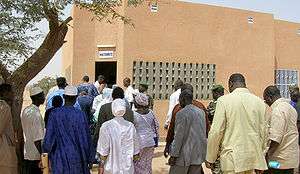Health in Niger

Public Health in Niger suffers from a chronic lack of resources and a small number of health providers relative to population. Some medicines are in short supply or unavailable.
Health infrastructure
There are government hospitals in Niamey (with three main hospitals in Niamey, including the National Hospital of Niamey and the Hôpital National De Lamordé), Maradi, Tahoua, Zinder and other large cities, with smaller medical clinics in most towns.[1]
Medical facilities are limited in both supplies and staff, with a small government healthcare system supplemented by private, charitable, religious, and Non-government organisation operated clinics and public health programs (such as Galmi Hospital near Birnin Konni and Maradi).[2]
Government hospitals, as well as public health programmes, fall under the control of the Nigerien Ministry of Health. A number of private for profit clinics ("Cabinets Médical Privé") operate in Niamey and other cities. The total expenditure on health per capita in 2005 was Intl $25. There were 377 Physicians in Niger in 2004, a ratio of 0.03 per 10,000 population. In 2003, 89.2 percent of individual expenditures on healthcare were "out-of-pocket" (paid by the patient).[2]
Health status
Malaria exists across the populated arc of southern Niger. Polio, as recently as 2000 considered endemic in places, exists as a small number of cases annually, mostly imported from northern Nigeria which in 2005 was the home of around 40 percent of the world's confirmed cases.[3][4]
Meningitis
Niger is within a belt of sub-Saharan Africa susceptible to seasonal outbreaks of Neisseria meningitidis: a meningococcal bacterial meningitis. These outbreaks tend to occur around the end of the "cold" season (temperatures dropping down to 15 degrees Celsius (59 degrees Fahrenheit) at night in some areas) in February to the beginning of the rainy season in May. The 2009 West African meningitis outbreak resulted in several thousand infections and more than one hundred deaths.[5][6][7][8]
Measles
Measles outbreaks still occur in Niger, in part due to the low vaccination rate and in part due to seasonal migration of rural populations. Sporadic outbreaks in Nigerien communities were found to have occurred beginning at the end of the rainy season, when many rural populations begin seasonal migration pattern, with traveling children often missing their vital second immunization booster against the disease.[9]
HIV/AIDS
2008 estimates ranged from 44,000 to 85,000 people living with HIV in a nation of around 14 million, with an adult (aged 15 to 49) prevalence rate of between 0.6% and 1.1%. Adults aged 15 and up living with HIV were estimated to range from 42,000 to 81,000, with women of this age range making up about a third (12,000 to 26,000). Estimates of children (under 14) living with HIV were between 2,500 and 4,200. Total deaths were estimated to be between 3,000 to 5,600 per year. Aids orphans (under 17) were estimated at between 18,000 and 39,000.[10]
Maternal and Child Healthcare
The 2010 maternal mortality rate per 100,000 births for Niger is 820. This is compared with 600.7 in 2008 and 890.1 in 1990. The under 5 mortality rate, per 1,000 births is 167 and the neonatal mortality as a percentage of under 5's mortality is 22. In Niger the number of midwives per 1,000 live births is 1 and the lifetime risk of death for pregnant women is 1 in 16.[11]
See also
External links
- The State of the World's Midwifery - Niger Country Profile
References
- ↑ REPUBLIC OF NIGER PRELIMINARY ATLAS OF POVERTY/VULNERABILITY. MAP 8: VILLAGES WITH CLINICS/HOSPITALS. Prepared for The World Bank Technical Department, Africa Region. 6 March 2001.
- 1 2 Niger. Country Health System Fact Sheet, 2006. World Health Organisation.]
- ↑ Polio Eradication Initiative: Program Overview. USAID, 2006.
- ↑ Progress Toward Poliomyelitis Eradication --- Nigeria, January 2007--August 12, 2008. MMWR Weekly. United States Centers for Disease Control. August 29, 2008 / 57(34);942-946
- ↑ "Nigeria: Battling the Lassa, CSM Outbreaks". All Africa. 2009-03-11. Retrieved 2009-03-15.
- ↑ "In Brief: Meningitis infections climb in Niger". IRIN News. 2009-03-09. Retrieved 2009-03-15.
- ↑ "West Africa: Meningitis Emergency Vaccine Stock Tapped Early". All Africa. 2009-03-05. Retrieved 2009-03-16.
- ↑ Agadez : des migrants vecteurs de la méningite. Ibrahim Manzo DIALLO, Aïr Info. 1 May 2009. Accessed 2009-06-04.
- ↑ Researchers Blame Seasonal Migration for Measles in Niger. Jessica Berman, Voice of America. 6 February 2008.
- ↑ UNAIDS country overview. Accessed 2009-02-20.
- ↑ "The State Of The World's Midwifery". United Nations Population Fund. Retrieved August 2011. Check date values in:
|access-date=(help)
- UNAIDS - Niger. Country situation analysis and news from the Joint United Nations Programme on HIV/AIDS.
- WHO/AFRO . Official site of the World Health Organization Regional Office for Africa (WHO/AFRO), Niger Health Statistics.
- Country Health System Profile - Niger . Trends in health policy, resources, and services, 2008.
- Malaria Country Profiles - Niger . Malaria information page from WHO/AFRO.
- World Food Program - Niger. The World Food Program (WFP), United Nations global hunger assessment, Niger.
- Nigerien health information from the World Health Organization
- NIGER: Northern desert conflict disrupts maternal health care. 26 August 2008 (IRIN).
- Niger-AIDS: Niger man breaks taboo on AIDS with "outing" on television. Agence France-Presse, 29 July 2002.
- Paul Bossyns and Wim Van Lerberghe. The weakest link: competence and prestige as constraints to referral by isolated nurses in rural Niger. Human Resources for Health. 2004, 2:1.
- Delivering Hope to Women with Fistula in Niger. UNFPA, the United Nations Population Fund. 25 September 2007.
- Niger: Niger To Build New Health Centres. AllAfrica. 5 January 2009.
- Weaver, Marcia; Holly Wong; Amadou S. Sarko et al. (1994). Prospects for reform of hospital fees in sub-Saharan Africa: A case study of Niamey National Hospital in Niger. Social Science and Medicine 38(4): 565-574.